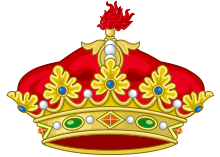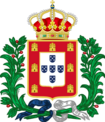Infante
Infante(Spanish:[iɱˈfante],Portuguese:[ĩˈfɐ̃tɨ];f.infanta), alsoanglicisedas "infant" or translated as "prince", is the title and rank given in theIberiankingdoms of Spain (including the predecessor kingdoms ofAragon,Castile,Navarre,andLeón) and Portugal to the sons and daughters (infantas) of the king, regardless of age, sometimes with the exception of theheir apparentorheir presumptiveto the throne who usually bears a unique princely or ducal title.[1]A woman married to a maleinfantewas accorded the title ofinfantaif the marriage wasdynasticallyapproved (e.g.,Princess Alicia of Bourbon-Parma), although since 1987 this is no longer automatically the case in Spain (e.g.,Princess Anne d'Orléans).[1]Husbands of borninfantasdid not obtain the title ofinfantethrough marriage (unlike mosthereditary titlesofSpanish nobility), although they were occasionally elevated to the titlede gracia( "by grace" ) at the sovereign's command.[1][2]
While the title belonged by right to all sons and daughters of a monarch (even when they ceased to be children of the reigning sovereign), it was also often accorded to sons-in-law and male-line grandchildren of the sovereign (e.g.,Prince Ferdinand of Bavaria,Infante Pedro Carlos of Spain and Portugal), sometimes to otheragnatesof the ruling dynasty (e.g.,Infante Enrique, Duke of Seville), and to female-line relatives of the monarch (e.g.Infante Sebastian of Portugal and Spain,Infante Alfonso de Orléans-Borbón).
History[edit]
Although the title is derived from the same root as "infant", inRomance languagesthe term may be more broadly interpreted to mean "child" (cf. Frenchenfants de France), and historically indicated that theinfanteorinfantawas the child of the nation's monarch.
Like theenfants de France,allinfantesin the various Iberian kingdoms wereprinces of the blood royal,although since 1987 the Spanish sovereign may also confer the titleinfantadoby decree upon a person (typically the spouse of aninfanteorinfanta) who is not of royal descent.
Spanish infantes[edit]

In the Spanish royal family, the dynastic children of the monarch and of theheir apparentare entitled to the designation and rank ofinfantewith the style ofRoyal Highness(infantes by birth). A second category ofinfantesmay be granted that title by royal decree (infantes by grace), but only bear the style ofHighness.[3]Previously, the title and rank ofinfante of Spainwas often granted to relatives and in-laws of Spain's monarchs, but unlike those created under the 1987 decree, their dynastic wives were automaticallyinfantasand bearers of the title wereRoyal Highnesses.
In addition, some distant relatives of Spanish sovereigns, usually children ofinfantes by grace,were accorded the "honours and treatment" ofinfanteorinfanta,but were not granted the title itself,[1][2]Included in this category were the children ofInfante Carlos de Borbón-Dos Sicilias' second marriage toPrincess Louise d'Orléans,those ofInfante Fernando de Bavaria y Borbón's marriage withInfanta Maria Teresa of Spain,[2]and those ofInfante Alfonso de Orléans-Borbón's marriage toPrincess Beatrice of Saxe-Coburg and Gotha(e.g.,Princess María de las Mercedes of Bourbon-Two Sicilies, Countess of Barcelona,Prince Alvaro de Orléans-Borbón, Duke di Galliera).[1]
Current infantes of Spain[edit]
The current infantes of Spain are (by precedence):
- Infanta Sofía(daughter of KingFelipe VIand Queen consortLetizia,younger sister ofLeonor, Princess of Asturias,the heir presumptive);
- Infanta Elena, Duchess of Lugo(elder daughter of former KingJuan Carlos Iand former Queen consortSofía);
- Infanta Cristina, former (stripped in 2015) Duchess of Palma(younger sister of above);
- Infanta Margarita, Duchess of Soria(younger sister of former King Juan Carlos I)
Portuguese infantes[edit]

Infantehad no feminine form at first in Portugal and may be compared to theinfançõesof the lowerPortuguese nobility,who were alsocadetsof their families with no prospect of inheriting the main possessions of the noble families to which they belonged, being distinguished in law by some prerogatives, but littlepatrimony.
Later, the wordinfantaemerged in Portugal as a feminised form applied to Portuguese princesses after the 16th and 17th centuries. Also, afterEdward, King of Portugal,in the 15th century, the heir apparent and his eldest son, or daughter if there was no son, came to be styled "prince" or "princess". The first prince in Portugal was the futureAfonso V,his eldest son, maybe adopting the French royal style by an English influence imported byPhilippa of Lancaster's retinue.
After the accession of theHouse of Braganzato the throne, thehonorificof "Most Serene" (Sereníssimo) was prefixed to the title ofinfante(Sereníssimafor aninfanta), since the complete appellation of this dynasty was "Most Serene House of Braganza" (Sereníssima Casa de Bragança), a style granted by thePope.The style, however, does not seem to have been used with the title ofPrince Royal.
Current infantes of Portugal[edit]
Portugal has been a republic since 1910. Close relatives ofDuarte Pio, Duke of Braganza,head of the Portuguese royal house, using the title are:[1][4]
- Infanta Maria Francisca, Duchess of Coimbra: Duarte Pio's 2nd child;
- Infante Dinis, Duke of Porto: Duarte Pio's 3rd child;
- Infante Miguel, Duke of Viseu: Duarte Pio's 2nd brother
Afonso, Prince of Beira,Duarte Pio's eldest son and heir apparent, is styledPrince of Beira,notinfante.
See also[edit]
- Cardinal-Infante (disambiguation)
- Portuguese monarchy
- Spanish monarchy
- Crown prince
- Spanish infantes
- Spanish infantas
- Portuguese infantes
- Portuguese infantas
- Leonese infantes
- Leonese infantas
- Castilian infantes
- Castilian infantas
- Aragonese infantes
- Aragonese infantas
Footnotes[edit]
- ^abcdefde Badts de Cugnac, Chantal. Coutant de Saisseval, Guy.Le Petit Gotha.Nouvelle Imprimerie Laballery, Paris 2002, p. 303, 364–369, 398, 406, 740–742, 756–758(in French),ISBN2-9507974-3-1.
- ^abc"The style of Infante | Infanta de España at Heraldica".Archived fromthe originalon 2017-09-05.Retrieved2011-11-09.
- ^Spanish:[1]Archived2008-06-24 at theWayback MachineThe Spanish Royal Decree 1368/1987, the regulation of Titles, Styles and Honors of the Royal FamilyBOE,Spanish Official Journal (accessed on October 27, 2008)
- ^"Casa Real Portuguesa – A Família Real".Archivedfrom the original on 2020-06-28.Retrieved2020-06-19.

